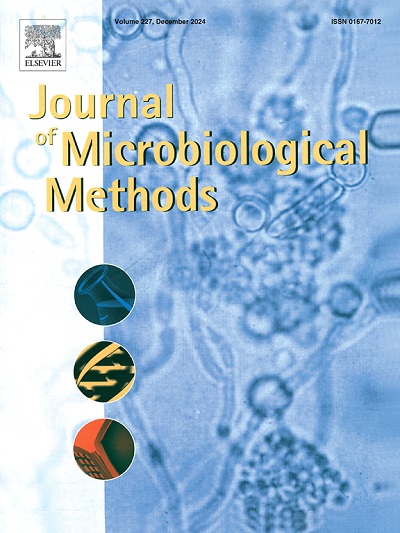A novel anti-C6 based approach for IgG avidity testing in Lyme borreliosis: A proof-of-concept study
IF 1.9
4区 生物学
Q4 BIOCHEMICAL RESEARCH METHODS
引用次数: 0
Abstract
Differentiating past from ongoing infection by serology is challenging. The sequential antibody response enables the detection of seroprogression on line immunoassays (LIA) but the different immunological age of antibodies, hence their different stage of affinity maturation also hinders IgG avidity determination. The conserved C6 segment of VlsE evokes an early, robust IgG response, thus might prove a suitable antigen for avidity measurements. Sera from 49 patients were tested (6 erythema migrans - EM, 22 post-primary – PP and 21 past infection). Paired sera were available from 24 patients in whom the diagnosis was confirmed by seroprogression and/or intrathecal antibody production (6 EM, 7 PP and 11 past infection). An in-house C6 avidity ELISA was used with 6 M urea solution and avidity-enhanced LIAs for representative samples. The avidity of reactive early and late antibodies differed on avidity-enhanced LIAs. Baseline C6 IgG intensity was higher in the PP group (EM vs. PP vs. past medians: 0.36 [IQR: 0.3–0.44] vs. 3.64 [IQR: 2.7–4.2] vs. 0.58 [0.36–1.1], p < 0.01, Kruskal-Wallis). C6 avidity at baseline did not differ in PP and past Lyme. Anti-C6 intensity and avidity evolved differently in the three groups between baseline and follow-up: in EM patients the avidity remained similarly low but the intensity increased (0.36 [0.3–0.44]) vs. 0.73 [0.62–0.87], p = 0.03, Wilcoxon); in PP Lyme the avidity increased (63.9 [42.1–73.6] vs. 74.7 [70–90.8], p = 0.03, Wilcoxon). Both the anti-C6 IgG avidity and intensity remained similar with residual antibodies from past infection. In conclusion, anti-C6 intensity and avidity changed as expected according to fundamental immunology. Anti-C6 IgG avidity testing might provide us with a useful, quantitative, supplementary tool in the future to differentiate past from active infection.
一种基于抗c6的莱姆病IgG抗体检测新方法:概念验证研究
通过血清学区分过去感染和正在感染是具有挑战性的。序列抗体反应能够检测血清进展在线免疫分析(LIA),但抗体的不同免疫年龄,因此它们的不同亲和成熟阶段也阻碍了IgG亲和度的测定。VlsE的保守的C6片段唤起早期,强大的IgG应答,因此可能被证明是一种适合用于贪婪测量的抗原。对49例患者的血清进行检测(6例迁移性红斑- EM, 22例原发性红斑- PP, 21例既往感染)。配对血清来自24例经血清进展和/或鞘内抗体产生确诊的患者(6例EM, 7例PP和11例既往感染)。采用C6亲和度ELISA, 6 M尿素溶液和代表性样品的亲和度增强LIAs。活性增强LIAs的早期和晚期抗体的活跃度不同。PP组C6 IgG基线强度较高(EM vs. PP vs.过去中位数:0.36 [IQR: 0.3-0.44] vs. 3.64 [IQR: 2.7-4.2] vs. 0.58 [0.36-1.1], p . 571
本文章由计算机程序翻译,如有差异,请以英文原文为准。
求助全文
约1分钟内获得全文
求助全文
来源期刊

Journal of microbiological methods
生物-生化研究方法
CiteScore
4.30
自引率
4.50%
发文量
151
审稿时长
29 days
期刊介绍:
The Journal of Microbiological Methods publishes scholarly and original articles, notes and review articles. These articles must include novel and/or state-of-the-art methods, or significant improvements to existing methods. Novel and innovative applications of current methods that are validated and useful will also be published. JMM strives for scholarship, innovation and excellence. This demands scientific rigour, the best available methods and technologies, correctly replicated experiments/tests, the inclusion of proper controls, calibrations, and the correct statistical analysis. The presentation of the data must support the interpretation of the method/approach.
All aspects of microbiology are covered, except virology. These include agricultural microbiology, applied and environmental microbiology, bioassays, bioinformatics, biotechnology, biochemical microbiology, clinical microbiology, diagnostics, food monitoring and quality control microbiology, microbial genetics and genomics, geomicrobiology, microbiome methods regardless of habitat, high through-put sequencing methods and analysis, microbial pathogenesis and host responses, metabolomics, metagenomics, metaproteomics, microbial ecology and diversity, microbial physiology, microbial ultra-structure, microscopic and imaging methods, molecular microbiology, mycology, novel mathematical microbiology and modelling, parasitology, plant-microbe interactions, protein markers/profiles, proteomics, pyrosequencing, public health microbiology, radioisotopes applied to microbiology, robotics applied to microbiological methods,rumen microbiology, microbiological methods for space missions and extreme environments, sampling methods and samplers, soil and sediment microbiology, transcriptomics, veterinary microbiology, sero-diagnostics and typing/identification.
 求助内容:
求助内容: 应助结果提醒方式:
应助结果提醒方式:


